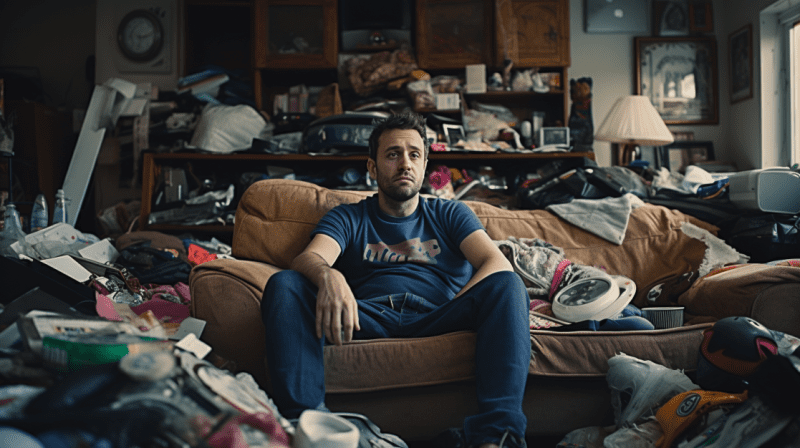
Are you preparing for a move but feeling overwhelmed by the sheer amount of stuff that needs to be addressed? You’re not alone! Even the most organized person can struggle to decide whether to store or sell all the items they have amassed over time. After all, it’s hard work finding an effective way of getting rid of your unwanted belongings without having regrets later on.
That’s why we are here today: To provide you with valuable advice and tips on decluttering before a big move!
How Soon Before Moving Should I Start Decluttering? (Timeline)
When getting ready for a move, it’s ideal to start decluttering 2-3 months ahead of time. This allows for sufficient time to efficiently go through your belongings and reduce the stress of a last-minute rush.
In fact, we crafted this timeline that will help you organize everything. Take a look at it!
8-12 Weeks Before Moving
Begin with items you rarely use, like seasonal gear and old clothes. It’s also a good opportunity to organize paperwork and records, even considering digitizing important documents. Evaluate your furniture and large items to determine what you’ll keep, sell, donate, or dispose of.
6-8 Weeks Before Moving
Continue the process room by room to avoid feeling overwhelmed. Make thoughtful decisions about sentimental items and take the time to address the emotional aspect of decluttering. If you have a lot of items to sell, consider hosting a yard sale or selling online.
4-6 Weeks Before Moving
As your moving date gets closer, concentrate on packing the items you’ve chosen to keep. Make sure to wrap and label boxes properly. Keep donating or recycling items you no longer desire. If you’re hiring a moving company, communicate your specific requirements.
2-4 Weeks Before Moving
Finalize the packing process and label boxes clearly. Confirm the details of your move with the chosen moving service and do a final check to ensure you haven’t overlooked anything during your decluttering.

8 Tips for Efficient Decluttering Before a Big Move
If you’re moving to a new city or downsizing to a more cozy space, here are some tips to simplify the decluttering process:
- Start Early: Begin decluttering well ahead of your move to avoid last-minute stress.
- Room-by-Room Approach: Take on one room at a time to stay organized and avoid feeling overwhelmed.
- Categories for Belongings: Sort your items into keep, donate, sell, and discard piles as you go through them.
- Sentimental Items: Preserve memories by taking photos or keeping small mementos to reduce clutter.
- Digitize Documents: Scan and save important papers and photos digitally to minimize paper clutter.
- Time Management: Allocate specific time slots each day for decluttering to stay focused and prevent decision fatigue.
- Proper Recycling and Disposal: Follow local regulations to responsibly dispose of items that can’t be sold, donated, or recycled.
- Ask for Assistance: Get input from friends and family to make the process more enjoyable.
Should You Store or Sell Your Stuff?

To store or to sell, that is the question!
And we just might have the answer… but it’s not that simple.
When faced with a major life change, such as moving, it can be a mix of excitement and feeling overwhelmed. This decision impacts finances, transition ease, and organization. Let’s explore the factors to consider when deciding what to do with your stuff.
Financial Factors
Start by assessing the value of your possessions, considering both their monetary and sentimental worth. Factor in the costs of moving these items. Is the expense of moving them worth more than what you could make from selling? While storage units offer convenience, they come with a price. Include these expenses in your financial calculations.
Emotional Attachment
Some belongings hold cherished memories or family history. Think carefully before parting with them. If your goal is to live a more minimalist lifestyle, selling might align better with your objectives. However, you can always store items that hold the most meaning without cluttering your new space.
Practicality
Think about the practicality of storing seasonal items like holiday decorations or sports gear that are only needed part of the year. Your future plans play a significant role here. If the move is temporary, storage may be the better choice. But if it’s a long-term move or downsizing, selling can be more practical.
Time and Effort
Decluttering takes time and effort. Selling your belongings can be financially rewarding but can also be time-consuming. If you’re in a hurry, storage might provide a quicker solution.
Flexibility
Life often brings unexpected surprises. There may be times when you want to hold onto your stuff for potential future use. Storage allows you to retain that flexibility without bidding farewell for good.
Choosing the Right Storage Option
10 Things to Consider

When it comes to choosing a storage solution, making the right decision is crucial, especially if you’re moving, downsizing, or in need of temporary storage. Here’s what you’ll want to consider:
Types of Storage
There are various storage options available, including traditional storage units, portable storage containers, and “pickup and delivery” storage.. Assess your specific requirements to determine the most suitable type for your belongings.
Location
Consider the proximity of the storage facility to your current or future residence, reducing the time and effort required to access your items.
Security
Ensure that the storage facility provides adequate security measures such as surveillance, secure access control, and well-lit areas. Your peace of mind is of utmost importance.
Size and Space
Calculate the required space for your belongings. Storage units are available in different sizes, allowing you to choose one that accommodates your items without paying for unnecessary space.
Climate Control
If you have sensitive items like electronics, furniture, or artwork, consider climate-controlled storage to safeguard against extreme temperatures, humidity, and potential damage.
Accessibility
Check the operating hours and accessibility of the facility. Some offer 24/7 access, while others have limited hours. Make sure they align with your schedule.
Cost
Storage costs can vary, so compare prices and inquire about any additional fees such as insurance or security deposits.
Duration of Storage
Determine how long you’ll need storage. Some facilities offer discounts for long-term commitments, while others are more flexible for short-term needs.
Insurance
Find out about insurance options for your stored items. Your homeowner’s or renter’s insurance might cover storage, but it’s essential to verify this with your provider.
Reviews and Recommendations
Research the facility by reading reviews and seeking recommendations from others who have used the same storage option.
How Do I Sell My Stuff Before Moving?
Maybe you’ve decided to sell some of your stuff.
Don’t worry, we got you covered for that as well! Here’s how you can make some extra bucks and get rid of things you don’t need anymore!
Again, it’s important to start early. Ideally, begin two to three months before your move. The first step is to create an inventory of the items you wish to sell. After identifying the items, research their value. Websites such as eBay, Craigslist, and local classifieds can provide insights into market prices.
When selling online, presentation plays a crucial role. Capture clear, well-lit photos of your items from various angles. Craft detailed and truthful descriptions that highlight any imperfections. Choose the appropriate platform to list your items. Popular options include online marketplaces like eBay, Craigslist, Facebook Marketplace, and specialized platforms like Poshmark for clothing.
Consider the timing of your sales; weekends often attract more buyers. If certain items don’t sell, you might want to consider donating them to charity or responsibly recycling them.
Bottom Line
Decluttering before your move is a total game-changer. When it comes to the big decision of storing or selling, it all comes down to your specific situation and goals. So, kick-start the process early, categorize your belongings, and consider what’s practical, sentimental, and financially savvy for you.





